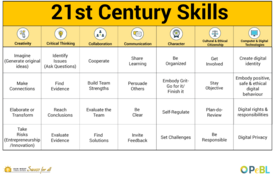Cultural and Ethical Citizenship Guidebook K-5 (Elementary) Sun West
Cultural and Ethical Citizenship Elementary K-5
Purpose
Why is this important?
Cultural and Ethical Citizenship is a key 21st Century skill that students need to embody in order to create and share their views and opinions, as well as expand their understanding of their role within a group as a leader and contributor. Having the skills and abilities to get involved, stay objective, plan-do-review, and be responsible, allows students to be successful participants in the planning of their learning and assessment.
Key Steps in Teaching Cultural and Ethical Citizenship Strategies
- Isolate the skill needed to be taught.
- Provide students with direct teaching to learn strategies and practice self-awareness.
- Provide and allow opportunities for students to practice the skills and strategies, and reflect often. This takes time at first, but students are rewarded for their efforts once they are able to master their practiced skill.
- Revisit strategies and skills often.
Explicit Teaching
To be able to learn and grow in 21st Century Competency understanding, it is important to teach each skill and let students experience what each skill looks like as well as how you can grow in each area. Caution: by simply saying the word "communication or collaboration...etc" students may not get a full understanding of each skill. Explicitly teaching and utilizing skills in different ways is what will ultimately promote deep understanding and growth in 21st Century Competencies.
Timeline Suggestions for Explicit Teaching
The document below provides a year plan to teach each of the 21st century skills. It is beneficial to have an explicit teaching plan to ensure each skill is taught; however skills should also be reinforced as much as possible throughout class time.
Lesson Plan Ideas
Get Involved
Citizenship Teach Guide: Grades 1-6
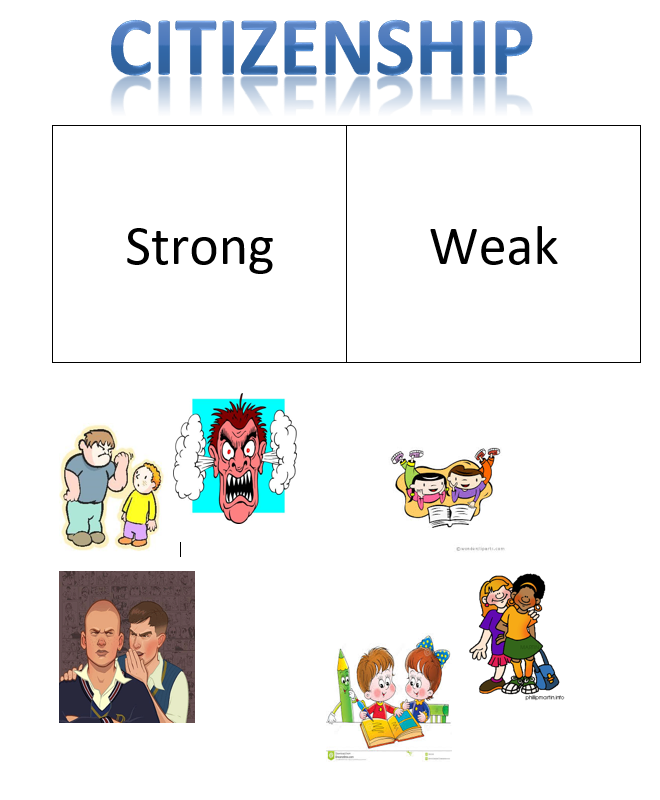
Example of Strong vs. Weak lesson for Kindergarten
Formalized Voting: Allowing students to vote on different things during the class day helps show students how the voting process works and reinforces student voice. Teachers often do this informally. A teacher might ask, "How many students want to play this reading game? How many want to play this one instead? Okay, the first one wins.". When a teacher makes the conscious decision to use formal voting terminology it makes this simple act exponentially more educational. Instead of simply stating which had the most votes a teacher may say, "Wow, ____ won by a landslide vote!" or "Someone didn't vote, it look like we have an absentee voter."
Stay Objective
Lesson Plan on diversity in the school and community:
Plan-Do-Review
Letter Writing
If you have ever entered a classroom full of 25 elementary aged kids, you know they are full of curiosity and suggestions. As a teacher it is important to fuel that curiosity and encourage their creativity. When a student comes to you with a question or concern, whenever possible, encourage them to research it. They should discover what the problem is, why it is something we should care about, and how they think it can be resolved. Then students can take initiative and contact the appropriate leader. These problems can be small, like whether or not they should have assigned seats at lunch. By doing their research and coming up with a valid argument, writing persuasive letters to the principal might instill change within the school. These problems they discover may be large, like a problem with stray animals in their local parks. Again, by doing research and brainstorming possible solutions, students can write a letter(s) to the mayor addressing the fact this is an issue important to them and they believe something should be done. This is the ultimate form of citizenship within the classroom. They are being active, engaged, and informed. It also ties in ELA through research and writing.
An important thing to keep in mind is that these are all great supplemental activities. They can easily be incorporated into the everyday elementary classroom, but should not be the only civic education being taught. Students need deeper and more thorough experiences with voting, community jobs, the constitution, and leaders. These activities serve as a way to help students build prior knowledge to a lesson or can help reinforce a lesson being taught, but should not be the primary teaching tool. I encourage you to give them a try and see how seamlessly citizenship can be integrated into any elementary classroom!
Be Responsible

Cut and Paste handout
Classroom Constitution
Like any good teacher knows, one of the first things we do when we get a new set of students is set up our classroom rules and expectations. A great way to allow student voice in this process is to allow them help brainstorm and create this list of rules they are expected to abide by. After the class has come to a consensus, each student may sign the chart or poster. The signature is an important part of this process. Here students are saying, “yes, I helped create these rules” and “yes, I agree to follow them”. This “classroom constitution” also provides the teacher the opportunity to teach a mini lesson over the constitution and compare and contrast the two documents if he/she chooses.
Classroom Community
Citizenship requires work, and part of being a citizen often means that you must take on a job. Creating a classroom community where students have the responsibility of managing a classroom job will allow them to see their work can affect others and others work can affect them. For example, having a designated student who is in charge of making sure all pencils are sharpened before class begins. If this student does not complete his or her job, then the rest of the students will not have sharp pencils to use. This may seem trivial, but yes, this is a real problem in elementary classrooms! Implementing jobs in the classroom teaches students that they are a part of a larger community that has to work together to make sure things continue to function and run smoothly.
Integration of Skills
Intentional integration of 21st Century Competency language in all day-to-day activities supports the development of routine reflection, skill use, and growth in support of curricular knowledge acquisition.
Why?
If we do not intentionally integrate 21st Century Competency connections into our learning environments, it is easy to forget about them. As the language becomes routine, growth in skills can and should be explored regularly. Ultimately the 21st Century Competencies are the skills needed to be successful in all day-to-day activities as well as future career opportunities. By being intentional in integrating the language and skill use in all aspects of learning, understanding of the skills can be applied and reflected upon to look for areas of potential growth and application.
How?
Once skills have been explicitly taught, integration of 21st Century Competencies can be achieved by connecting skills to all curricular areas, participating in pre-and post reflections (allowing students to predict which skills will be needed and subsequently which skills need to be worked on) and the use of 21st Century Competency rubrics to track growth. Example: by using learner profile data, students can reflect on which skills they need to employ for a particular activity and based on this information, choose group members that have strengths or challenges in those skill areas.
Examples
When integrating 21 Century Competency language in all areas of learning consider the following curricular connected resources. As you use similar resources in your own learning environment, how can you relate them back to growth and understanding of the 21 Century Competencies?
In ELA
Big themes in ELA connect to many aspects of cultural and ethical citizenship. Be sure to included regular lessons on the following topics, and providing ample opportunity to practice, share and reflect.
- The ELA strands (reading, writing, speaking and listening) as best taught objectively and by considering, and respecting, others views and perspectives. Encourage students to stay objective and be responsible when learning.
- Explicitly teaching students the writing process, and the benefits of plan-do-review will aid them in goal setting beyond the classroom.
- Model to students, and support their desires to, get involved. By supporting volunteerism within the classroom and school community students will become stronger citizens as a whole.
In Math
Students can show their cultural and ethical citizenship skills in Math as well! Therefore, it is important to discuss and model these skills using the following opportunities for your students:
- Being responsible is important in math as students need to complete practice questions and follow course timelines.
- Students should embody leadership skills, invite unique ideas, and encourage others to do their best while solving problems in pairs or small groups.
- Teach students to set goals in math and follow the plan-do-review method to remain on task and succeed in the process.
Teachable moments
Whenever a question, situation, comment or activity that involves a connection to a 21 Century Competency arises, take a moment to talk to students about it. Discussing skills, how they integrate into everything you do in life makes the reflection on the importance of skills a habit. This habit will instill a growth mindset around developing skills to their fullest potential. Teachable moments can be as short as 20 seconds. Make it your habit and it will become theirs!
Tracking Growth
When considering 21st Century Competency application, it is essential for both the teacher and the student to track growth. There is clear potential for growth in skill use throughout our lives. To ensure growth and understanding of application is taking place, we can easily track progression using rubrics, checklists, and self-assessments.
Formative Assessment
Formative assessments of 21st Century Competencies include anecdotal documentation, self-assessments and rubric check-ins. These formative assessments provide snapshots of growth throughout the learning process and allow goal setting to take place.
See below for Self-Reflection and Goal Setting Documents:
Assessing Growth
Summative Assessment
Co-creating Rubrics
Exemplar rubrics have been developed for
K-5, 6-9 and 10-12. To connect fully with students in their understanding of
skill application and growth, a recommendation would be to re-write the rubric
with the students to include their understanding of the skill, goals for
integration in learning and commitment to the skill development.
Exemplar Rubrics:
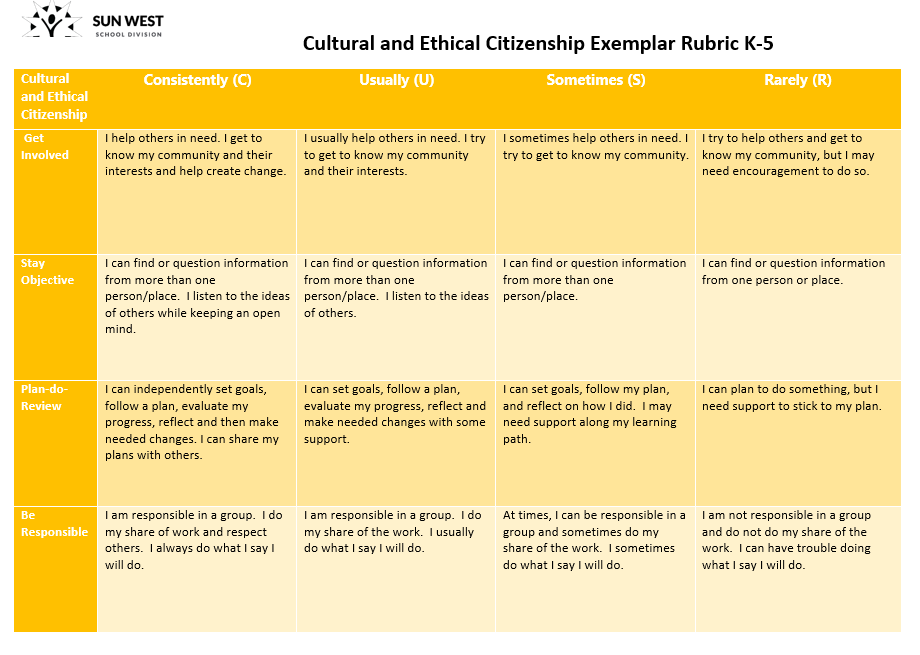
Cultural & Ethical Citizenship K-5
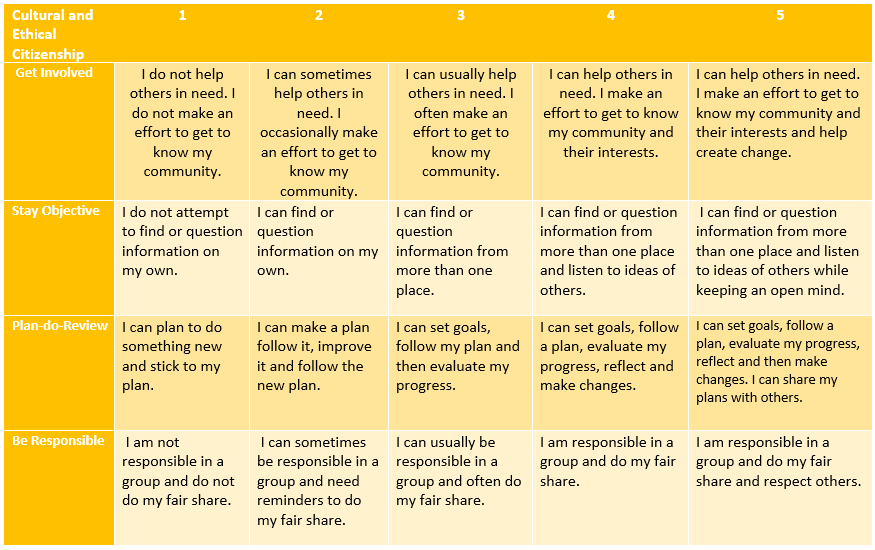
Exemplar Rubric
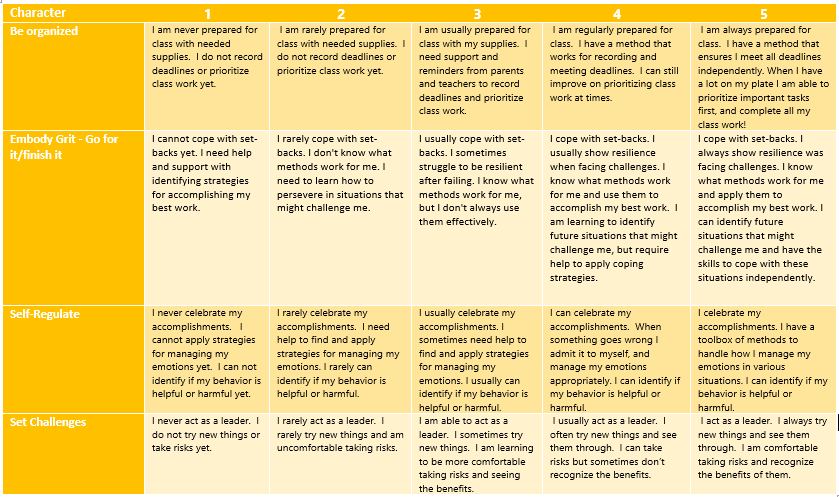
Character Exemplar 6-9
Resources
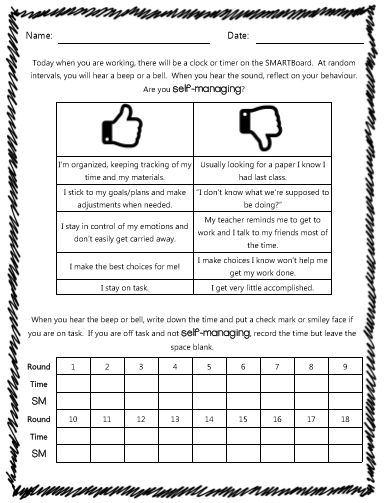
Self - Regulation for students
Print based
Concentus Citizenship Education Resource Packages Gr.6-9 (An awesome resource and related website for teaching citizenship - Canadian Based
Digital Citizenship in Schools by Mike Ribble: Book on digital citizenship and ways of incorporating lesssons and PD in schools if wishing to explore Cultural and Ethical Citizenship through a Digital Citizenship perspective.
Videos
Interactive
Educational Articles
Citizenship and Elementary Education - How do you teach that?
How to Teach Citizenship in the Elementary School Classroom
Websites
Citizenship Education Foundation (Canadian)
If deciding to explore Cultural and Ethical Citizenship through the lens of Digital Citizenship, refer to the Computer and Digital Technologies Guidebook and the websites below:
Common Sense Media – Lesson plans for every grade level focused on positive digital citizenship (American site, but lots of good resources).
Media Smarts: This is Canada’s Centre for Digital and Media Literacy. There are a number of resources and ideas for teachers, parents, etc. to help explore digital citizenship and proper use of technology.
